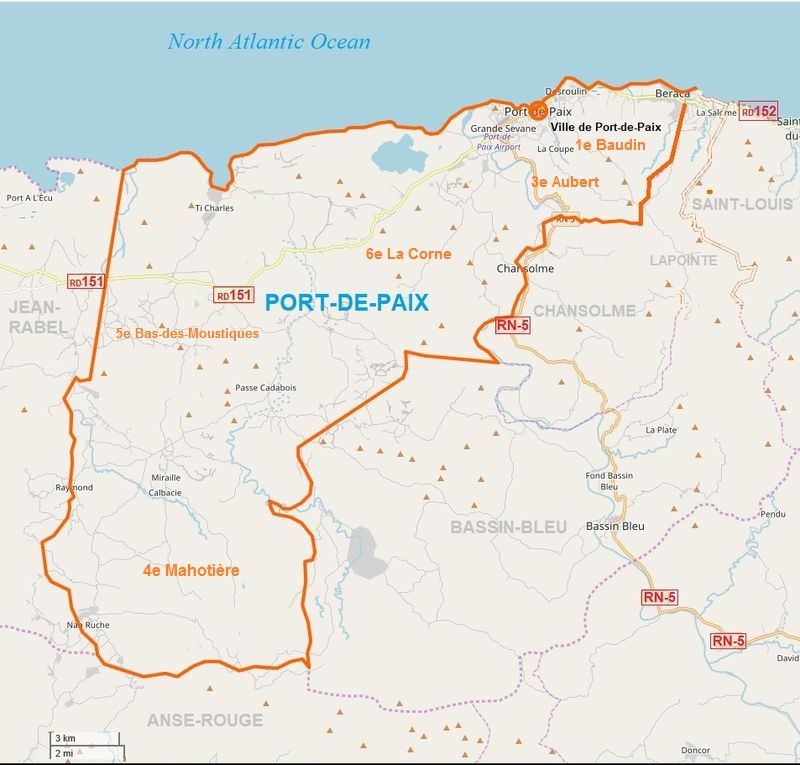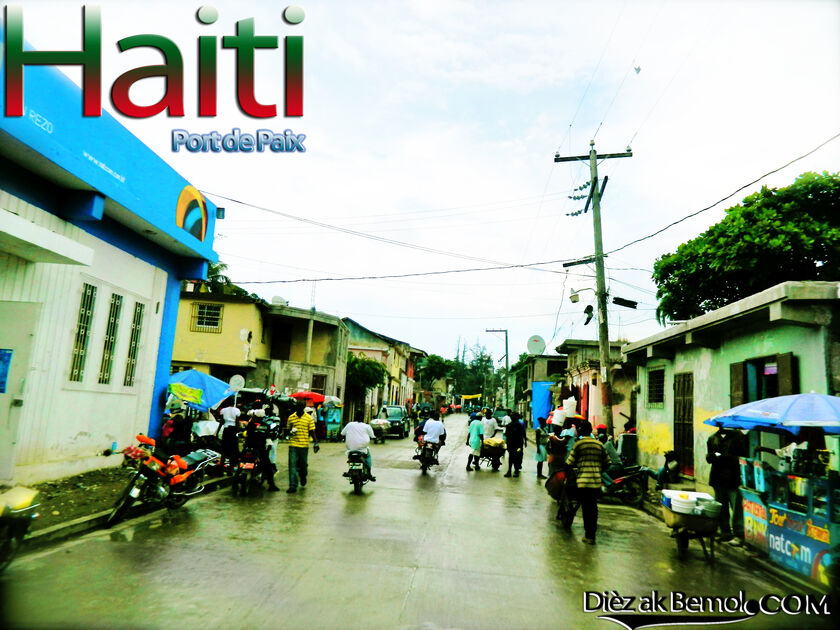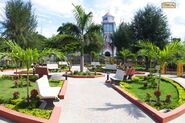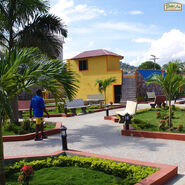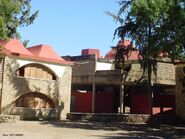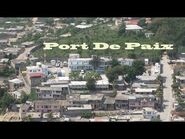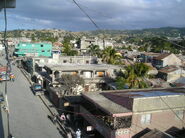"A country that can't feed it's people is condemned to be the servant of others."
Ansi Vixima, Tèt Kole Ti Peyizan peasant movement.
Port-de-Paix (Kreyol: Podpè) (English: Port of Peace) is capital of the Northwest Department and chief city of the Port-de-Paix Arrondissement.
Port-de-Paix is Haiti's fourth largest capital city and its tenth most populous city. French insurrectionists established the coastal metro area in 1665. The Port-de-Paix Arrondissement is made up of four communes: Port-de-Paix, Bassin-Bleu, Chansolme, and Tortuga Island. Tortuga Island and Port-de-Paix are Haiti's northernmost communes.
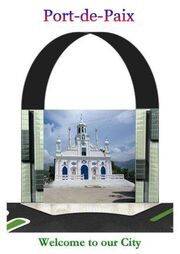
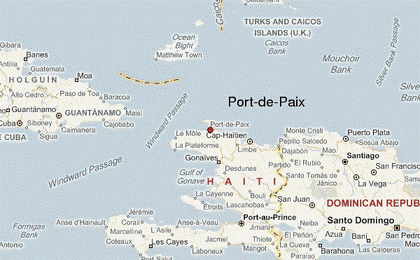
Location in Haiti
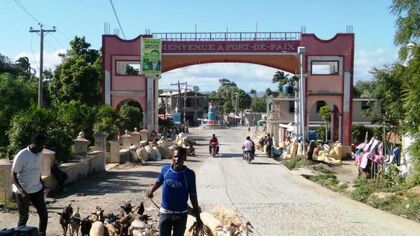
Welcome sign
History
The city was initially discovered in 1492 by Christopher Columbus, who called it Valparaiso. The French, who had settled Saint-Domingue during the 1600s, made Port-de-Paix its capital after they had been ousted from Tortuga Island by the British. In 1679 Port-de-Paix witnessed the initial black slave uprising, which was to last a decade. By the 19th century, Port-de-Paix was prospering. However, in 1902 a fire broke out and raged through the city, completely demolishing it. Since that time, it has never made a full recovery.
Geography
Port-de-Paix, chief place of the North West Department, was raised to the rank of commune in 1812. In the old days of the Spanish, this commune was called Valparaiso. After the departure of the Spaniards in favor of many changes that have taken place, it took the name of "Port-de-Paix" which it has preserved to this day. This commune has seven communal sections. The inhabitants of the commune are called Port-de-Paisien. The relief of the commune of Port-de-Paix is dominated by hills, plateaus and plains. Its climate varies from normal to cool according to its geographical position which is both coastal and inland. The municipality of Port-de-Paix has an area of 401.54 km2. The urban section of Port-de-Paix has an area of 8 km2 (3 Square miles) and a density of 15,501 people per km2 (40,407 people per Square mile).
Demographics
| Year | Population | +/- |
|---|---|---|
| 1998 | 105,767 | |
| 2004 | 121,000 | +13% |
| 2015 | 194,045 | +38% |
Neighborhoods
| PDP | Port-de-Paix | 194,045 | |||
|---|---|---|---|---|---|
| VPX | Ville de Port-de-Paix | Urban | 121,220 | ||
| BAU | 1ère Section Baudin | Rural section | 13,287 | Bras Homme, Daudin, Grand Etang (Ou Déroulin), La Croix, Lallemand, La Pointe, Madelon, Nan Dubuy, Nan Masse, Trois Pavillons. | |
| Separated from Port-de-Paix in March 2015. | |||||
| AUB | 3ème Section Aubert | Rural section | 9,685 | Aubert, Bois Rouge, Cachina, Deux Mélisses, La Coupe, La Tendrie, Mare Denis, Petit Etang, Polvo | |
| MAH | 4eme Section Mahotière | Rural | 25,603 | Atraille, Bananier, Bangouinyote, Bas Mahotière, Beauchamp, Cléante, Fond Dubois, Gerbe-à-Flèche, Grand Fond Ti Noël, Gros Cajou, Jourdin , Mahotière, Marc Caluc, Michel, Nan Aimé, Nan Coton, Nan Coucou, Nan Couteau, Nan Gouine, Nan Maillette, Nan Palmiste, Nan Roche, Quisa, Raymond, Saline Maillette. | |
| BAM | 5eme Section Bas des Moustiques | Rural | 13,726 | Bambou la Selle, Bananier Colas, Bombay, Calebassier, Chérubin, Danda Caillo, Desjardin, Digoterie, Figue banane, Foison, Fond Farde, Fond Ti Bonheur, Fond Ti Cousin, La Carrière, Les Fonds, Manvion, Mare Plate, Nan Cocoyé, Nan Rémy, Passe Catabois, Piton Mouri, Poste Métier, Roche Couteau, Rosette, Ti Charles, Ti Cousin, Zeb à flèche. | |
| LCN | 6eme Section La Corne | Rural | 10,524 | Audrouin, Bois Milot, Cordier, Ford Coq, Haut Fourneau, Jean Denis, La Saline, Nan Jean Louis, Paulin, Terre Brûlée. |
Economy
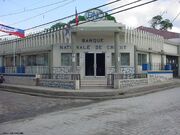
Local bank
With regard to economic and financial establishments, the commune of Port-de-Paix is better equipped than the others. It has three banks, however, it does not have a Caisse populaire. There are also hotels, a pension, about a dozen restaurants, two home centers and a marketing cooperative.
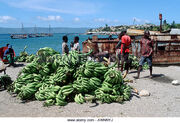
Bananas prepared for export
A rich agricultural area, it grows coffee, bananas, tobacco, rice, and cacao. Because the city is so accessible to the U.S. via the Atlantic, a flourishing smuggling trade has developed in Port-de-Paix since the 1990s.
Infrastructure
Transportation
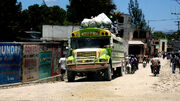
Bus to Port-au-Prince

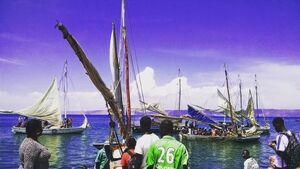
Port-de-Paix Harbor
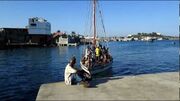
Boats to Tortuga Island: Port-de-Paix, Haiti
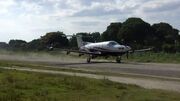
Port-de-Paix Airport [1]
Port-de-Paix's transportation infrastructure is well developed, being served by many regional airlines. They offer flight service from Port-de-Paix Airport to Toussaint Louverture International Airport, located in Port-au-Prince, and to Cap-Haitien International Airport in Cap-Haïtien. A ferry operation carries tourists between the beautiful beaches of Port-de-Paix and Tortuga Island.
Education
The Ministry of the National Education of Youth and Sport is represented in the municipality by a departmental direction. The person in charge is a departmental director responsible for supervising his activities. Assisted by its staff, it coordinates certain activities and establishes a plan of operation concerning the different schools within this municipality. The distribution of schools is as follows Five private school at the kindergarten level and at the primary level 11 public schools, numerous private, and 6 congregational. For the secondary level there are two Public Schools numerous private schools and one Congregational School.
Healthcare
The Ministry of Public Health and Population is represented in the commune of Port-de-Paix by a departmental directorate. For health care facilities there are two non-bed health centers, two hospitals, 13 clinics and three medical laboratories. In addition, a team consisting of doctors and dentists, nurses and auxiliaries, many certified matrons and a dozen laboratory technicians, provide the health service at the various health centers of the municipality.
Utilities
As for water availability, five rivers, two dozen Springs and a pond were inventoried in the municipality. For the other water points, eight artesian wells, public fountains with at least 25 taps and also three pumps were recorded. The water coming from the public fountains is the most used. It is used for domestic use and especially for drinking. About Electricity, a large part of the commune of Port-de-Paix is electrified. The HRE is the institution responsible for electricity in this commune. It provided an average of 56 hours/week.
Security
With regard to administrative and judicial infrastructures, the commune of Port-de-Paix has a peace court, in the city at Rue Dumarsis Estime. There is also a prison.
Culture
Religion
With respect to Religion, more than 100 temples of all faiths were counted in the commune of Port-de-Paix. These confessions are: Catholics, Adventist Baptists, Pentecostal and Jehovah's Witnesses. The number of Pentecostal temples and churches of God is better represented are 44% of the total.
Organizations
With regard to the political parties and organizations that have gone through the city and the communal sections, there are seven political parties, 34 popular organizations, six peasant groups, thirteen Women's groups, three non-commercial cooperatives, six NGOs and four International organizations.
Communication
In terms of Communication, the municipality of Port-de-Paix has no "newspapers/journals" but has seven radio stations and a television station.

Woman in Port-de-Paix
In Port-de-Paix, radio stations abound, many of them FM, and a few broadcast over the Internet. Fans of Compás in Port-de-Paix favor such music artists as Shoubou de Tabou Combo, Cubano de Skah Shah, and Drumcp.
Leisure
As for leisure, the Gaguères, numbering six, constitute the main places of distraction for the inhabitants of the commune. For other types of entertainment, four football (soccer) fields, two basketball courts that are in poor condition, a Theatre room and six night clubs have been inventoried at the level of this municipality.
Twin towns and Sister Cities
Port-de-Paix is a twin city of Oakland, California, USA, as recognized by Sister Cities International.
Urban project
A special working session, called by the nation's Prime Minister, who also acts as Haiti's Minister of Planning and External Cooperation, Laurent Lamothe, was held recently for many hours to facilitate the special plans for the city of Port-de-Paix.
The important project is one of renewal for city, which, according to the prime minister, have been neglected for far too long at 25 years. As such, the vow to do all that is necessary to upgrade the city was made; a venture that found traction with the session's other participants. Present for the meeting were Senators, along with the mayor of Port-de-Paix, the Minister of Public Works and the Minister Delegate in charge of Human Rights and the fight against extreme poverty.
The discussion included priority points, such as the roads, public spaces, airports and grounds for sporting events as well as the social, environmental and agricultural outlook of the region. As for the Northwest, a final plan for the renovation of Port-de-Paix has been submitted to the Monitoring Committee.
The bill for these plans already tally $5 million, so far between the plans for Port-de-Paix airport's feasibility studies and renovation.
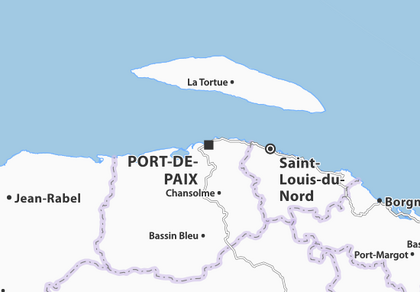
Area map
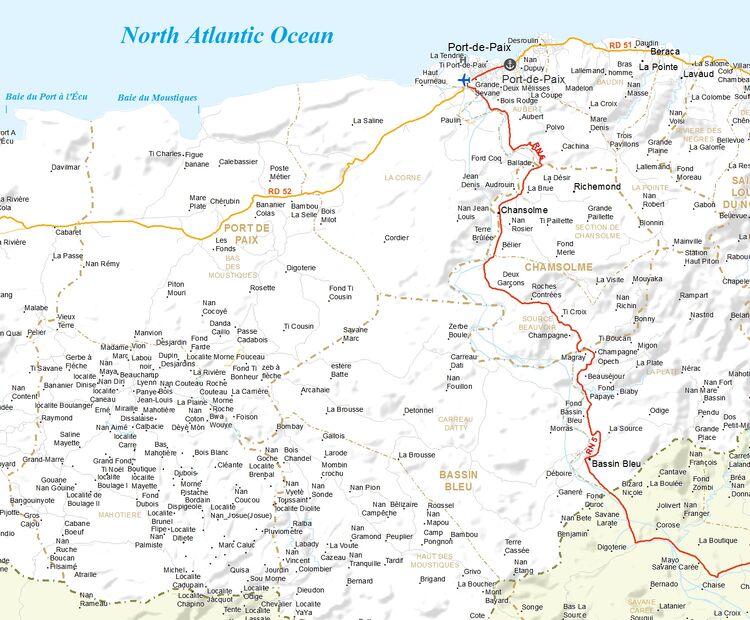
Michael Vedrine
